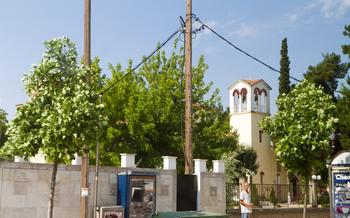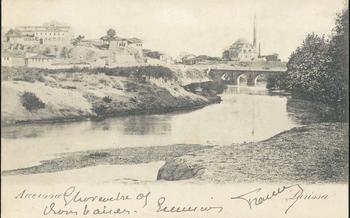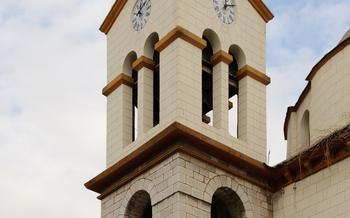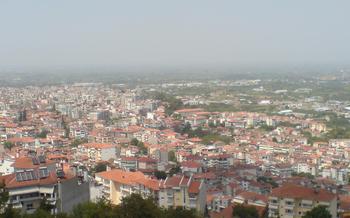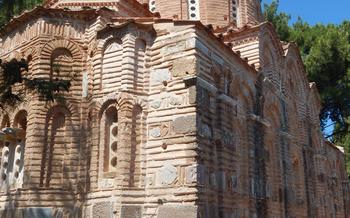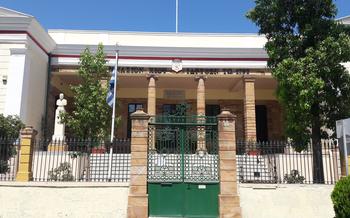
The Church of Agios Ioannis Prodromos
- The Church of Agios Ioannis Prodromos: A Historical Overview
- Location: Finding the Church in Xanthi
- Exploring the Church's Exterior
- Stepping Inside: The Church's Interior
- The Story of Saint John the Baptist
- Witnessing a Greek Orthodox Service
- Admiring the Iconostasis
- Attending a Festival or Event
- Taking a Guided Tour
- Exploring the Neighborhood
- Photographing the Church
- Respecting Local Customs
- Planning Your Visit: Essential Information
- Insider Tip: Hidden Gems and Local Secrets
The Church of Agios Ioannis Prodromos: A Historical Overview
Nestled in the heart of Xanthi, Greece, stands the Church of Agios Ioannis Prodromos, a magnificent monument that has witnessed centuries of history and devotion. Built in the 12th century, this Byzantine masterpiece is a testament to the region's rich cultural and religious heritage. The church's architectural style, characterized by its intricate carvings and imposing dome, reflects the grandeur of the Byzantine era. Its cultural and religious significance extends beyond its physical presence, as it serves as a sacred gathering place for the local community and a symbol of Xanthi's spiritual identity.
Throughout the years, the Church of Agios Ioannis Prodromos has been the subject of numerous anecdotes and legends, adding to its mystique and allure. Locals recount tales of miraculous healings and divine interventions associated with the church, further solidifying its status as a revered sanctuary.
Location: Finding the Church in Xanthi
The Church of Agios Ioannis Prodromos is situated in the heart of Xanthi's old town, a picturesque neighborhood known for its well-preserved architecture and vibrant atmosphere. To locate the church, head to the central square, Plateia Eleftherias, and follow the charming cobblestone streets leading north. After a short walk, you'll find the church standing prominently on your right, just off the main road.
Nearby landmarks include the Old Town Hall, a majestic building that now houses the Municipal Art Gallery, and the Xanthi Tobacco Museum, which offers a glimpse into the city's rich industrial heritage. The church is easily accessible by foot, and several public transportation options are available for those who prefer not to walk. Buses and taxis stop nearby, making it convenient to reach the church from anywhere in Xanthi.
Whether you choose to stroll through the old town's narrow streets or take public transportation, finding the Church of Agios Ioannis Prodromos is a breeze. Once you step into its vicinity, the church's imposing presence will guide you to its doorstep, inviting you to explore its architectural wonders and spiritual significance.
Exploring the Church's Exterior
The Church of Agios Ioannis Prodromos stands as a testament to the architectural prowess of its builders. Its exterior boasts a unique blend of Byzantine and Ottoman influences, creating a visually striking edifice. As you approach the church, take a moment to admire its intricate carvings and decorations, which adorn every corner and surface. These carvings depict various biblical scenes, saints, and symbols, each with its own story to tell. Look out for historical inscriptions etched into the stone, providing glimpses into the church's rich past.
To fully capture the grandeur of the church's exterior, position yourself at a distance and let your eyes wander from the base to the towering dome. The play of light and shadow on the intricate carvings creates a mesmerizing effect, especially during the golden hours of sunrise and sunset. For photographers, this is the perfect opportunity to experiment with different angles and lighting conditions to capture the church's beauty in all its glory. Remember to respect the sanctity of the site and be mindful of ongoing religious services when taking photographs.
Stepping Inside: The Church's Interior
Upon crossing the threshold of the Church of Agios Ioannis Prodromos, visitors are immediately struck by the ethereal atmosphere within. The walls and ceiling are adorned with breathtaking frescoes, each brushstroke imbued with sacred significance. The iconography depicts scenes from the life of Christ, the Virgin Mary, and various saints, inviting the faithful to contemplate their divine presence.
In the center of the church stands a magnificent iconostasis, a masterpiece of Byzantine art that separates the nave from the sanctuary. Intricately carved and adorned with gold leaf, it features a series of icons depicting Jesus Christ, the Virgin Mary, and other saints, each with their own unique story to tell. The intricate details and vibrant colors of the iconostasis create a sense of awe and wonder, inviting the faithful to engage in prayer and meditation.
The church also houses a collection of sacred relics and religious artifacts, each with its own story to tell. Among these treasures are the remains of Saint John the Baptist, the church's patron saint, whose presence is believed to bestow blessings upon the faithful. The relics are encased in a silver reliquary, placed prominently within the church, where pilgrims and visitors come to pay their respects and seek divine intervention.
The overall atmosphere within the Church of Agios Ioannis Prodromos is one of profound spirituality and reverence. The combination of stunning frescoes, sacred relics, and intricate iconography creates a sanctuary where visitors can connect with their faith and experience a sense of inner peace and tranquility.
The Story of Saint John the Baptist
In Christianity, Saint John the Baptist holds a significant position as the precursor to Jesus Christ. Known for his asceticism and powerful preaching, he baptized Jesus in the Jordan River, marking a pivotal moment in the Christian narrative. The Church of Agios Ioannis Prodromos in Xanthi is dedicated to this revered saint, reflecting the deep connection between the church and Saint John's legacy.
Local traditions and celebrations surrounding Saint John the Baptist add to the cultural significance of the church. On his feast day, January 7th, Xanthi comes alive with religious processions, special services, and community gatherings. Devotees pay homage to the saint, seeking his blessings and guidance. Anecdotes and legends passed down through generations further enhance the mystique surrounding Saint John, making the church a site of both historical and spiritual importance.
Witnessing a Greek Orthodox Service
Attending a Greek Orthodox service at the Church of Agios Ioannis Prodromos offers a profound immersion into the spiritual and cultural heart of Xanthi. The service, conducted in Greek, is a beautiful blend of ancient traditions, intricate rituals, and heartfelt devotion.
As you enter the church, the air is filled with the sweet fragrance of incense and the gentle flickering of candlelight. The faithful stand reverently, their heads bowed in prayer. The service begins with the chanting of hymns by the choir, their voices harmonizing beautifully beneath the vaulted ceilings.
The priest, adorned in resplendent vestments, leads the congregation through a series of prayers, scripture readings, and rituals. The atmosphere is one of deep devotion and contemplation, as the faithful immerse themselves in the sacredness of the moment.
If you're fortunate, you may witness the sacrament of Holy Communion, where the bread and wine are consecrated and shared among the congregation. This is a particularly poignant moment, as the community comes together in a shared expression of faith and unity.
While attending a Greek Orthodox service, it's important to be mindful of local customs and etiquette. Dress modestly, and avoid wearing shorts or revealing clothing. Refrain from taking photos or using flash during the service, as this may be disruptive.
If you're unsure about any aspect of the service, don't hesitate to ask a local or the priest for guidance. They'll be happy to assist you and ensure that you have a meaningful and respectful experience.
Admiring the Iconostasis
In the heart of the Church of Agios Ioannis Prodromos, the iconostasis stands as a magnificent partition, separating the nave from the sacred sanctuary. This masterpiece of ecclesiastical art is a testament to the intricate craftsmanship and profound symbolism that pervades the church.
Crafted with meticulous care, the iconostasis is adorned with a multitude of icons, each representing a significant figure from the Christian faith. The vibrant colors and intricate details of these icons captivate the eye, inviting visitors to delve into their rich symbolism.
The iconostasis serves not only as a physical barrier but also as a spiritual threshold, guiding the faithful towards the contemplation of the divine mysteries. It is a tangible reminder of the sacredness of the sanctuary and the presence of the divine within the church.
To fully appreciate the beauty and significance of the iconostasis, take a moment to study the individual icons. Learn about the saints and biblical figures depicted, and contemplate their role in the Christian narrative.
It is also worth noting the unique craftsmanship of the iconostasis itself. Observe the delicate carvings, the intricate filigree work, and the harmonious blending of colors. These elements combine to create a masterpiece that is both aesthetically pleasing and deeply meaningful.
Attending a Festival or Event
In addition to being a place of worship and historical significance, the Church of Agios Ioannis Prodromos is a vibrant venue for various festivals and cultural events throughout the year. The church's courtyard and surrounding area transform into a lively hub of activity during these special occasions.
One of the most significant events is the annual feast day of Saint John the Baptist, celebrated on June 2The church comes alive with religious processions, traditional music and dance performances, and a festive atmosphere that draws locals and visitors alike. The day is marked with special services, processions through the streets of Xanthi, and a grand feast shared by the community.
The church also hosts seasonal events, such as Christmas concerts and Easter celebrations, where the community gathers to share the joy and spirit of these holidays. These events offer a unique opportunity to witness traditional Greek Orthodox rituals, experience the warmth of the local hospitality, and immerse oneself in the rich cultural heritage of Xanthi.
Taking a Guided Tour
In addition to self-exploration, guided tours are an excellent way to delve deeper into the history, architecture, and art of the Church of Agios Ioannis Prodromos. Tours are available in multiple languages, ensuring that visitors from all corners of the globe can appreciate the church's significance.
Led by knowledgeable and passionate guides, these tours provide insights that might otherwise go unnoticed. Learn about the church's construction, its role in Xanthi's religious and cultural heritage, and the symbolism behind its intricate iconography. Guides can also point out hidden details and lesser-known stories that add to the overall experience.
Guided tours are an excellent option for groups looking for a more comprehensive and enriching visit. With a guide to navigate the church's complexities, visitors can gain a deeper understanding and appreciation for this architectural and spiritual gem.
Practical Tips for Booking a Tour: - Reserve your spot in advance, especially during peak tourist season, to avoid disappointment. - Inquire about group discounts or special rates for students and seniors. - Choose a tour that aligns with your interests, whether it focuses on history, architecture, or religious significance. - Arrive a few minutes early to ensure a smooth start to the tour.
Exploring the Neighborhood
Beyond the church's walls, Xanthi's old town unveils its captivating charm. Wander through the labyrinthine streets, adorned with traditional houses and shops that whisper stories of the past. Admire the unique architecture, where Ottoman and Greek influences harmoniously blend, creating a visual tapestry.
Stroll along the picturesque riverbanks, where locals gather to soak in the tranquil ambiance. Cross the historic bridges, each carrying its own tale, and discover hidden corners that exude a timeless aura.
Indulge in the local culinary delights at traditional tavernas, savoring authentic Greek dishes prepared with fresh, seasonal ingredients. Engage with the friendly locals, who are always eager to share their stories and offer recommendations.
Explore the vibrant markets, where vendors display an array of local products, from handmade crafts to fresh produce. Immerse yourself in the lively atmosphere as you haggle for the best prices and uncover hidden treasures.
Xanthi's old town is a living testament to the region's rich history and diverse culture. By venturing beyond the church, you will discover a world of hidden gems, local traditions, and authentic experiences that will leave an indelible mark on your memories.
Photographing the Church
In capturing the essence of the Church of Agios Ioannis Prodromos, photography plays a crucial role. To harness the church's picturesque beauty, consider these tips:
-
Golden Hours: Embrace the magic of "golden hours" - sunrise and sunset - when natural light bathes the church in a warm, ethereal glow, enhancing its architectural splendor.
-
Composition and Perspective: Experiment with various angles to create dynamic compositions. Stand back for a panoramic shot showcasing the church's grandeur or move closer to highlight intricate details.
-
Interior Details: Capture the intricate frescoes and iconography within the church. Use a wide-angle lens to capture the expansive interior, and don't forget to adjust your camera settings for low-light conditions.
-
Respectful Approach: Be mindful of ongoing religious services or ceremonies. Avoid using flash photography, as it can be disruptive. Seek permission before taking photos of individuals, especially during prayer or contemplation.
Respecting Local Customs
When visiting the Church of Agios Ioannis Prodromos, it is essential to show respect for local customs and traditions. Dress modestly, covering your shoulders and knees, especially for women. Avoid wearing shorts, tank tops, or revealing clothing. When taking photos, ask permission before photographing people, especially during religious services. Refrain from using flash photography, as it can be disruptive. Observe religious practices and rituals quietly and respectfully, without talking or making noise. If you are unsure about any customs or etiquette, don't hesitate to ask a local or a tour guide for guidance. Being mindful and respectful of local traditions will ensure a positive and enriching experience for everyone.
Planning Your Visit: Essential Information
When planning your visit to the Church of Agios Ioannis Prodromos, it is essential to consider the following practical information:
-
Operating Hours: The church is generally open to the public during daylight hours, but specific hours may vary depending on the season and religious holidays. Visitors are advised to check the church's official website or inquire with local tourism offices for the most up-to-date information.
-
Admission Fees: Entrance to the church is typically free of charge, allowing visitors to explore its beauty and sacredness without financial barriers. However, donations are welcome and greatly appreciated, as they contribute to the church's upkeep and preservation.
-
Accessibility: The church is accessible to individuals with disabilities, ensuring that everyone can experience its architectural and spiritual wonders. Ramps and designated seating areas are available to facilitate ease of movement and participation in religious services.
-
Tips for Planning: To make the most of your visit, consider the following practical tips:
- Dress respectfully, covering your shoulders and knees, as a sign of respect for the sacred nature of the church.
- Be mindful of the ongoing religious services and maintain a quiet and reverent atmosphere within the church.
- Take advantage of the natural light during the daytime to capture stunning photographs of the church's intricate architecture and frescoes.
- If you are visiting during a religious festival or event, be prepared for crowds and immerse yourself in the vibrant atmosphere and local traditions.
Insider Tip: Hidden Gems and Local Secrets
Beyond the main attractions, the Church of Agios Ioannis Prodromos holds hidden gems and local secrets waiting to be discovered. Take a moment to explore the courtyard, where you'll find a serene fountain and a small garden with colorful flowers. Behind the church, a hidden staircase leads to a rooftop terrace, offering panoramic views of Xanthi's old town and the surrounding countryside.
Engage with the locals to uncover their favorite spots. They might recommend a nearby bakery known for its traditional pastries or a hidden taverna serving authentic Greek cuisine. Ask about local festivals and events that showcase Xanthi's vibrant culture. Embrace the opportunity to delve deeper into the community and create lasting memories.


